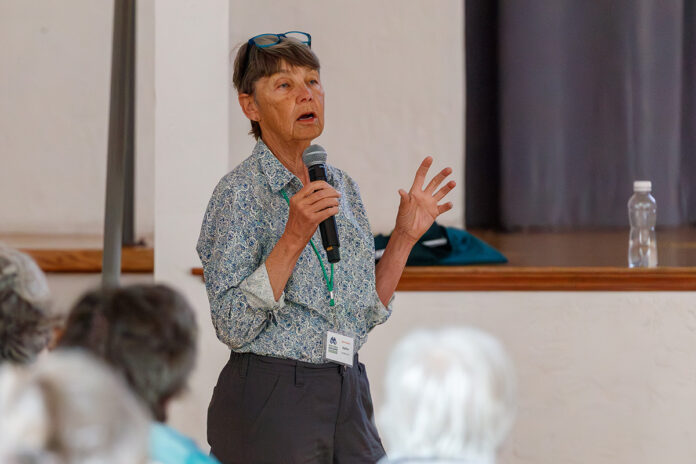Birder Kathe Anderson hosted a talk on “Basic and Bizarre Bird Behavior” as part of the Verde Valley Birding and Nature Festival on Thursday, April 25, at the Cottonwood Community Clubhouse.
Anderson said that the main reasons birds migrate is for food, but mating and nesting are also factors. When migrating, birds use navigational tools including the sun, stars, smell, vision, geomagnetism and low-frequency sound waves. About 75% of North American land birds migrate to some extent and birds gain up to 50% of additional body weight when preparing to migrate.
Some of the birds that Anderson referred to as “migration masters” were the arctic tern, which flies 22,000 miles each year but weighs only four ounces; the bar-tailed godwit, which can fly between 5,000 and 7,000 miles without stopping; and the blackpoll warbler, weighing only half an ounce, which flies the Atlantic nonstop when migrating.
Once birds make it to their migratory territory, they sing. Anderson said this behavior serves two main purposes: To proclaim their territory and to attract a mate. Woodpeckers similarly start pecking when they arrive in a new territory, not only on trees but all sorts of surfaces and objects.
Anderson said that many birds “dress up” to find a mate by performing unique behaviors and displays. In the avian world, females typically choose the males, which has created a selective pressure giving rise to many bizarre adaptations, such as colors, shapes and behaviors, that make males more attractive to females.
The great egret grows long feathers that flutter in the wind and the color near its eyes becomes an iridescent green, while the ruddy duck’s bill turns blue and its coat changes to a shiny brown color. The greater sage grouse struts while puffing out the air sacs on its chest and the western grebe, a water bird, performs a synchronized dance. The Australian fairy wren, prey of the gray butcherbird, will fly to the top of a tree and sing when it hears the presence of the butcherbird. Anderson speculated that the male does so in an attempt to impress females with an act of bravery or successful survival.
Since hummingbirds can often be difficult to identify, Anderson explained that one way to more easily identify them is by their mating displays. The male Anna’s hummingbird, for instance, will make a popping noise with its tail during its display.
Following mating, birds need to build a nest. Anderson said that greater black-backed gulls will “discuss” a nesting site, with the females walking around a site and vocalizing their agreement or dissent.
The wren family, which includes Arizona’s state bird the cactus wren, all make multiple nests. The male house wren makes as many as three to seven nests in different places throughout its territory, then gives the female a “real estate tour,” Anderson joked. They often steal nesting material from other birds’ nests. Birds make nests from all sorts of materials. Barn swallows make their nests by collecting bits of mud, while the killdeer, a shorebird, is known to nest in the most inconvenient places, such as a flat roof with no nesting material. Mourning doves can nest in saguaros and other cacti and red-headed woodpeckers nest in tree holes. Brown-headed cowbirds don’t make their own nests but place their eggs in other bird’s nests, an approach known as nest parasitism.
“It’s a pretty remarkable process,” Anderson said.
Cowbirds lay between 30 and 40 eggs in a season and have to keep an eye on the various nests to make sure that their eggs are successful. They must figure out the territory, time it right and make sure the other baby birds will be smaller than theirs.
Baby birds grow an egg tooth, a tiny lump at the tip of their bill, to peck their way out of their egg. Anderson said most birds, like house wrens, are helpless as soon as they emerge from the egg, but a Canadian gosling will be on its feet right away.
Birds preen to keep clean. This takes a lot of time for birds and is important for them to keep their feathers clean. They have a preen gland under the tail which secretes oil. The birds take the oil and run it through their feathers. Allopreening is a bonding pair behavior that occurs when birds preen each other, and can be seen in budgerigars and burrowing owls. Birds also bathe in water and dust.



